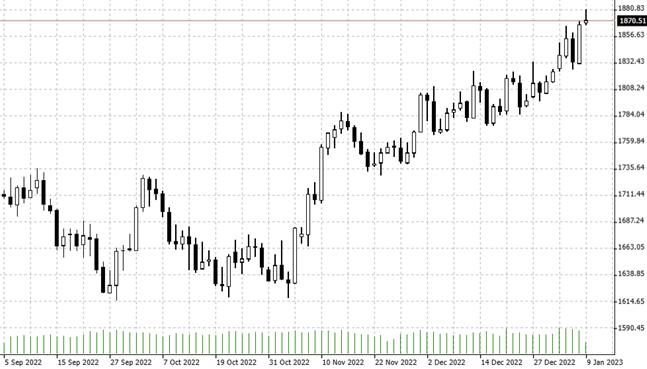

09.01.2023 – The “Masters of the Universe” have given the thumbs up: Goldman Sachs is bullish on gold. The price continues to rise. Especially since good news has also arrived from China.
What a pretty run for gold since October, here’s the daily chart. One of the reasons: In the middle of last week, the gold men sent out their bullish note to institutional clients. It said, “Throughout 2022 we saw ETFs selling gold and Asian physical demand from either central banks or retail soaking it up.” So index funds in the West were selling and Asia was buying; we’ll see exactly who below.

Source: Bernstein Bank GmbH
We think: Presumably many investors in the U.S. and Europe feared a recession plus job loss or experienced it due to the Corona requirements and cashed out to make ends meet.
Inflation or deflation
The R-word also plays a role in Goldman Sachs’ thinking; the investment bank sees three possible scenarios for gold related to monetary policy. Either the Federal Reserve will leave the course of interest rate hikes too early. However, even after the end of the cycle in 2018, gold still presented a rally of 20 percent. Or the Fed will set the pivot too late – and this could trigger a major recession. Our 50 Cents: Gold has traditionally been the safe haven in both inflation and deflation. The least bullish scenario for the precious metal, according to Goldman Sachs, would be a successful soft landing, meaning inflation is contained and the economy does not go belly up.
China is buying again
Remains a look at the Middle Kingdom. China bought 32 tons of gold in November – the first official purchase since September 2018. Finally, this Saturday, the People’s Bank of China reported on its website a further increase of 30 tons in December. All told, Beijing now holds 2,010 tons.
Monetary guardians stock up
It remains to add that the world’s central banks are heading for a record level of purchases in 2022, or at least a multi-decade high, as the global lobbying association World Gold Council explained. From the first to the third quarter of 2022, currency holders stocked up on a net 673 tons, according to the report. Data for the full year is expected to be reported in mid-January.
The question remains why central banks are buying so heavily at the moment. Presumably because they either expect a global devaluation of paper money – after all, they know best whether to take on new debt and fire up the printing press. Or they fear a big crash, with people turning to gold and silver as a means of payment. See Goldman Sachs’ comments above. In any case, we are experiencing a bit of a gold rush right now, which we are of course keeping an eye on. Bernstein Bank wishes successful trades and investments!
__________________________________________________________________________________________
The content of this publication is for general information purposes only. In this context, it is neither an individual investment recommendation or advice nor an offer to purchase or sell securities or other financial products. The content in question and all the information contained therein do not in any way replace individual investor- or investment-oriented advice. No reliable forecast or indication for the future is possible with respect to any presentation or information on the present or past performance of the relevant underlying assets. All information and data presented in this publication are based on reliable sources. However, Bernstein Bank does not guarantee that the information and data contained in this publication is up-to-date, correct and complete. Securities traded on the financial markets are subject to price fluctuations. A contract for difference (CFD) is also a financial instrument with leverage effect. Against this backdrop, CFD trading involves a high risk up to the point of total loss and may not be suitable for all investors. Therefore, make sure that you have fully understood all the correlating risks. If necessary, ask for independent advice. CFDs are complex instruments and are associated with the high risk of losing money quickly because of the leverage effect. 68% of retail investor accounts lose money trading CFD with this provider. You should consider whether you understand how CFD work and whether you can afford to take the high risk of losing your money.7
